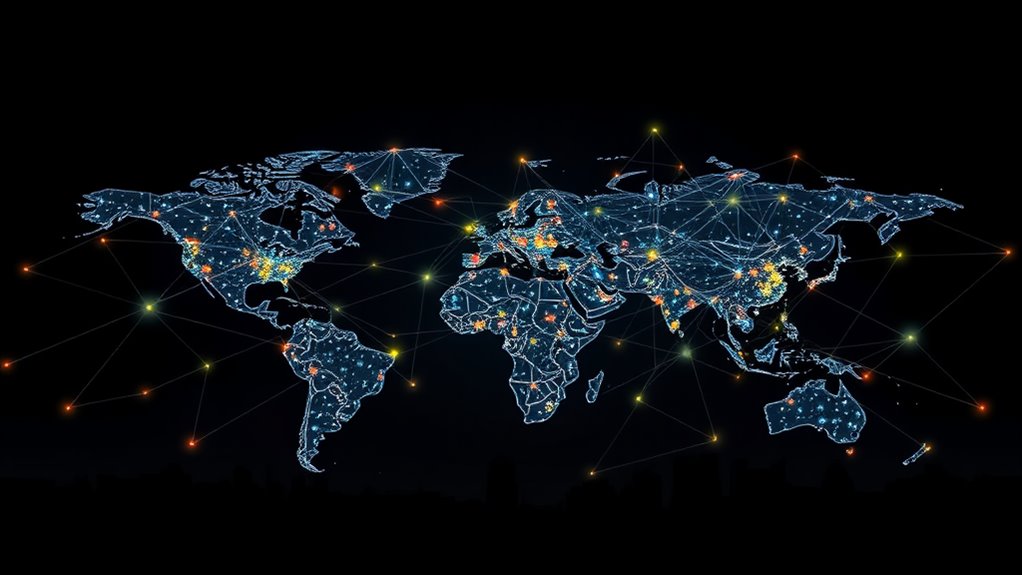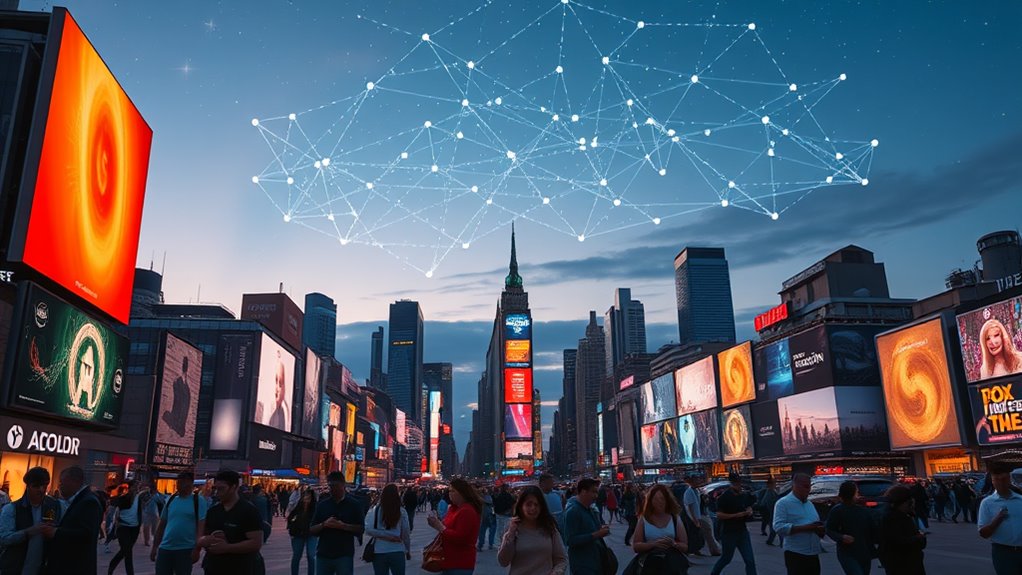
Decentralization and Its Importance: A Guide to Understanding Its Benefits
Decentralization fundamentally transforms how power, resources, and decision-making are distributed across networks and organizations. This system eliminates single points of control, enhancing security and resilience while promoting transparency and innovation. Through distributed governance, communities gain autonomy in managing resources and implementing local solutions. Economic benefits include reduced barriers to entry, improved market efficiency, and equitable resource distribution. The integration of blockchain technology and smart contracts further amplifies these advantages, marking the beginning of a more democratic digital future.
Key Takeaways
- Decentralization eliminates single points of failure and distributes power across networks, enhancing system security and resilience against attacks.
- Local decision-making authority enables communities to respond quickly to specific needs and create more effective solutions.
- Economic barriers are reduced as decentralization promotes fair resource distribution and creates opportunities for smaller market participants.
- Transparent and tamper-proof record-keeping through blockchain technology increases trust and reduces dependency on intermediaries.
- Community-driven initiatives foster innovation and collaboration, leading to diverse perspectives and improved problem-solving approaches.
The Core Principles of Decentralized Systems

While many modern systems rely on centralized control, decentralized systems operate on a fundamentally different set of principles that distribute power, authority, and decision-making across multiple independent nodes or participants.
These systems are built upon key principles that guarantee their effectiveness and reliability. Transparency and openness serve as foundational elements, providing clear visibility into operations and fostering trust among participants.
Each node maintains autonomy, allowing for flexible decision-making and adaptation to changing conditions. The distributed nature of these systems enhances security and resilience, making them less vulnerable to complete failure.
Additionally, decentralized structures encourage innovation by incorporating diverse perspectives and allowing evolutionary improvements over time, creating a robust framework for sustainable operation and growth.
Through consensus mechanisms, participating nodes validate and verify transactions collectively, ensuring the integrity of the entire network without requiring central oversight.
Why Decentralization Matters in Modern Technology

Building upon the core principles of decentralized systems, modern technology has experienced a significant transformation through the implementation of decentralized architectures. The shift toward decentralization has revolutionized how data is stored, transactions are processed, and trust is established across networks.
This transformation addresses key challenges in modern technology by promoting transparency, eliminating intermediaries, and enhancing security through distributed systems.
- Decentralization guarantees transparent and accessible transaction data, fostering trust among participants while reducing reliance on traditional intermediaries.
- The distributed nature of decentralized systems provides enhanced security through tamper-proof record-keeping and reduced points of failure.
- Innovation flourishes as developers can freely contribute to open networks, creating applications ranging from cryptocurrencies to supply chain management solutions.
Technologies like blockchain-powered smart contracts are revolutionizing industries by automating and securing digital agreements without the need for traditional intermediaries.
Breaking Down the Economic Impact of Decentralization

The economic landscape of decentralization reveals a compelling pattern where financial barriers rapidly diminish as markets adapt to distributed systems.
Market participants, driven by new incentives created through decentralized structures, actively contribute to sustained economic growth across various sectors.
Research indicates that this transformation leads to increased market efficiency, with data showing that decentralized systems often generate more equitable distribution of resources and opportunities among participants.
The integration of blockchain with AI creates powerful synergies that further enhance transaction efficiency and security across financial markets.
Financial Barriers Dissolve Fast
As economic systems evolve toward decentralization, financial barriers that once restricted growth and innovation steadily dissolve, creating unprecedented opportunities for local economies and market participants.
Studies demonstrate that decentralized systems accelerate decision-making processes, reduce bureaucratic obstacles, and enhance fiscal performance through improved resource allocation. Local governments gain the ability to implement customized economic solutions, leading to more efficient public spending and increased accountability.
- Fiscal decentralization increases public spending efficiency by up to 10%, with funds directed according to specific community needs
- Local decision-making enables rapid response to economic challenges, reducing approval times and administrative bottlenecks
- Competition among regional governments drives better economic policies, resulting in improved service delivery and resource management
The removal of traditional financial barriers through decentralization creates a more dynamic, responsive, and efficient economic environment.
Similar to how blockchain technology enhances transparency and efficiency in enterprise operations, decentralized systems create more reliable audit trails and reduced operational costs.
Incentives Drive Market Growth
Market growth in decentralized systems flourishes through carefully designed incentive structures that reward participation and innovation. These systems create opportunities for smaller firms and entrepreneurs by reducing barriers to entry and eliminating unnecessary intermediaries, leading to more efficient resource allocation and reduced transaction costs.
The incentive framework promotes healthy competition while supporting regional autonomy in economic decision-making. Studies show that smaller businesses respond more effectively to economic development incentives compared to large corporations, contributing to sustainable local growth.
Additionally, decentralized markets encourage open innovation and collaboration among diverse participants, fostering product development and market adaptability. This approach enables communities to implement tailored economic strategies that align with their specific needs while maintaining the flexibility to respond quickly to changing market conditions. Thoughtful regulation of decentralized systems can help legitimize digital assets while preserving their innovative potential.
Security Advantages of Decentralized Networks

While traditional centralized networks present considerable security vulnerabilities, decentralized networks offer superior protection through their distributed architecture and elimination of single points of failure. The distribution of data across multiple nodes enhances network resilience against cyberattacks, while cryptographic protocols guarantee data integrity. This architecture makes it markedly more challenging for attackers to compromise the system, as there is no central point to target.
- Data distribution across nodes reduces the impact of potential breaches, preventing complete system compromise.
- Consensus mechanisms and cryptography work together to maintain network security and validate transactions.
- Recovery from attacks or failures happens swiftly due to redundant data storage and automated failover systems.
The security advantages of decentralization extend beyond mere data protection, encompassing system-wide resilience and enhanced privacy measures through distributed governance. Full nodes maintain complete copies of the blockchain, providing an additional layer of security by independently verifying all network transactions.
Empowering Communities Through Distributed Governance

Distributed governance empowers communities by shifting decision-making authority from centralized bodies to local entities, allowing residents to have direct input on matters affecting their daily lives.
Through this model, communities gain control over resource allocation and distribution, ensuring that local needs and priorities receive appropriate attention and funding.
The establishment of collective power structures through distributed governance creates a framework where community members can actively participate in shaping policies, implementing solutions, and monitoring outcomes that impact their neighborhoods.
Local Decision-Making Authority
Local decision-making authority represents a fundamental pillar of decentralized governance, enabling communities to exercise direct control over policies and initiatives that affect their daily lives.
Through established mechanisms like elected officials and autonomous local bodies, communities gain the power to address their specific challenges with tailored solutions. This authority strengthens democratic participation while improving the efficiency and responsiveness of local governance structures.
- Local authorities can make decisions more quickly and effectively, as they understand the immediate needs and cultural context of their communities.
- Community members develop stronger trust in government processes when they see direct results from their participation in decision-making.
- Decentralized authority allows for diverse perspectives and solutions, leading to more innovative approaches to local challenges.
Community Resource Distribution
Building upon the foundation of local decision-making authority, effective community resource distribution emerges as a powerful mechanism for strengthening decentralized governance.
Modern technologies, including blockchain and edge computing, enable communities to manage and allocate resources efficiently through secure, transparent systems. These technological tools support decentralized networks that allow communities to pool resources and coordinate decisions without centralized control.
Fiscal decentralization transfers financial decision-making to local levels, while community capitalism leverages local financial institutions to foster economic growth.
This approach, combined with participatory governance models, guarantees resources are distributed based on actual community needs. The implementation of decentralized autonomous organizations (DAOs) and other blockchain-based tools further enhances transparency and accountability in resource management, creating more resilient and self-sufficient communities.
Supply chain management systems built on blockchain technology enable communities to track and verify resource distribution with unprecedented accuracy and trust.
Collective Power Structures
As organizations and communities evolve beyond traditional hierarchical models, collective power structures emerge as essential frameworks for achieving meaningful decentralization. These structures distribute authority across different levels, fostering inclusive decision-making and shared leadership while amplifying marginalized voices.
Through decentralized governance, organizations can build resilience, enhance communication, and promote innovation through diverse perspectives.
- Non-hierarchical models, such as circles and committees, guarantee power sharing and collaborative decision-making processes.
- Distributed authority systems improve organizational transparency, accountability, and adaptability during times of change.
- Implementation requires careful consideration of scalability challenges, regulatory barriers, and the necessary cultural shift toward shared leadership.
The success of organizations like Pangea Legal Services and Movement Generation demonstrates how collective power structures can effectively transform traditional governance models while promoting sustainable growth and community engagement.
Similar to smart contracts in DeFi platforms, decentralized governance structures enable transparent and automated decision-making processes without traditional intermediaries.
The Role of Decentralization in Digital Innovation

While digital transformation continues to reshape industries worldwide, decentralization has emerged as a cornerstone of technological innovation. Technologies like AI, blockchain, and cloud computing have enabled organizations to distribute control and decision-making across various operational units. This technological shift supports innovative tools and platforms that facilitate remote collaboration among geographically dispersed teams.
The adoption of decentralized systems guarantees enhanced security and operational resilience by eliminating single points of failure. Modern network architectures support seamless data flow across locations while enabling the integration of advanced analytics and AI technologies.
These systems align particularly well with emerging workforce expectations, as they promote autonomy and purpose-driven work. The result is a more adaptable, secure, and efficient digital ecosystem that supports continuous innovation and organizational growth. Organizations must carefully evaluate whether public or private blockchains best serve their specific security and privacy requirements when implementing decentralized solutions.
Navigating the Technical Aspects of Decentralized Platforms

The technical foundations of decentralized platforms require careful navigation through multiple architectural layers and security protocols. These platforms operate on blockchain technology, utilizing smart contracts and distributed ledger systems to guarantee secure, transparent transactions without traditional intermediaries.
The architecture consists of distinct layers that work together to provide extensive financial services while maintaining security and user accessibility.
- Settlement Layer processes transactions through blockchain technology, creating an immutable record of all financial activities.
- Application Layer incorporates smart contracts to automate complex financial operations and enforce rules without human intervention.
- Interface Layer provides user-friendly access points, allowing individuals to interact with the underlying technology effectively.
Each component plays a vital role in maintaining the integrity and functionality of decentralized systems, while supporting innovation in financial services. Many decentralized platforms like Ethereum use proof of stake consensus mechanisms to validate transactions and maintain network security.
Real-World Applications and Success Stories

Decentralized Finance (DeFi) lending platforms have demonstrated remarkable success, with protocols like Aave and Compound processing billions of dollars in loans while maintaining user autonomy and competitive interest rates.
The implementation of decentralized energy grids has enabled communities to trade excess solar power directly with neighbors, reducing dependency on traditional utility companies and lowering overall energy costs.
These real-world applications showcase how decentralization creates tangible benefits, from increasing financial accessibility to optimizing resource distribution in local communities.
DeFi Lending Platforms Success
Modern DeFi lending platforms have revolutionized traditional financial services by implementing innovative solutions that address long-standing barriers in the lending industry.
Leading platforms like Aave, Compound, and MakerDAO have demonstrated remarkable success through their innovative approaches to decentralized finance, attracting billions in total value locked while maintaining operational stability and user trust.
- Aave's introduction of flash loans created a new paradigm for uncollateralized borrowing, enabling sophisticated trading strategies and arbitrage opportunities.
- Compound's democratic governance model empowers users to actively participate in platform decisions, fostering community engagement and sustainable growth.
- MakerDAO's DAI stablecoin system provides a reliable foundation for lending operations, maintaining price stability through complex algorithmic mechanisms and user-supplied collateral.
Decentralized Energy Grid Benefits
As global energy demands continue to evolve, decentralized energy grids have emerged as a transformative solution for sustainable power distribution, offering numerous environmental, economic, and technological benefits.
Real-world applications demonstrate their effectiveness, particularly in rural communities where traditional power infrastructure is limited. These systems successfully provide reliable energy access while reducing carbon emissions through renewable sources like solar and wind power.
Implementation of decentralized grids has shown measurable success in remote regions, where communities now maintain energy independence through self-sufficient solutions.
Commercial and residential sectors have adopted these systems, integrating them into microgrids that guarantee consistent power supply during outages. The technology's effectiveness is further enhanced through real-time monitoring and data analysis, leading to improved energy efficiency and reduced operational costs.
Overcoming Common Obstacles in Decentralized Systems

While implementing decentralized systems offers numerous advantages, organizations and developers must navigate several significant obstacles to achieve successful deployment. The challenges span technical, financial, and regulatory domains, requiring thorough solutions and careful planning to overcome these barriers effectively.
- Technical complexity presents a substantial hurdle, as organizations must manage sophisticated systems while ensuring security and maintaining user accessibility through improved interfaces and automated processes.
- Financial constraints impact adoption, with high transaction fees and hardware requirements necessitating innovative solutions like layer-2 scaling and efficient consensus mechanisms.
- Regulatory uncertainty across jurisdictions demands careful navigation, requiring organizations to balance compliance requirements with decentralization principles while establishing clear frameworks for operation.
Future Prospects and Emerging Trends in Decentralization

The future landscape of decentralization reveals transformative developments across multiple sectors, driven by technological innovations and increasing market demand.
Advanced blockchain technology and Web 3.0 development are creating systems where users maintain greater control over their data and digital assets. The integration of artificial intelligence with decentralized platforms enhances operational efficiency, particularly in DeFi applications and infrastructure management.
Decentralized Physical Infrastructure (DePIN) solutions are gaining prominence in smart city initiatives, offering cost-effective and resilient alternatives for energy and transportation systems.
Additionally, innovations in zero-knowledge proofs and interoperability solutions are addressing privacy concerns while enabling seamless communication between different blockchain networks.
These developments, combined with increasing institutional participation and the convergence of IoT technologies, suggest a future where decentralized systems become increasingly integrated into everyday operations.
Frequently Asked Questions
How Does Decentralization Affect Environmental Sustainability and Energy Consumption?
Decentralization enhances environmental sustainability through localized resource management and renewable energy adoption. It promotes energy efficiency by enabling region-specific solutions, though success depends on effective coordination between local and central authorities.
What Role Do Social Dynamics Play in Maintaining Decentralized Communities?
The Mastodon social network demonstrates how social dynamics empower users through shared governance, collaborative moderation, and inclusive spaces. Community members actively participate in decision-making, fostering trust and sustainable engagement within decentralized platforms.
Can Decentralized Systems Effectively Handle Emergency Situations and Rapid Response Needs?
Decentralized systems can effectively manage emergencies through localized response teams, swift decision-making, and community-based resources. However, success depends on proper coordination, clear communication channels, and established emergency protocols across participating units.
How Does Decentralization Impact Intellectual Property Rights and Patent Protection?
Powerful patent protection in decentralized systems presents paradoxes. Blockchain technology enables transparent ownership tracking and automated licensing, but challenges arise with cross-border enforcement, anonymity issues, and jurisdictional complexities in intellectual property rights management.
What Are the Psychological Barriers to Adopting Decentralized Systems?
Psychological barriers to adopting decentralized systems include steep learning curves, fear of technological complexity, trust issues with autonomous systems, and anxiety about security. Users often struggle with uncertainty in non-traditional control structures.
Conclusion
Like a resilient web spanning across digital horizons, decentralization continues to reshape our technological landscape. The evidence demonstrates its capacity to enhance security, foster innovation, and democratize access to resources. As organizations and communities increasingly embrace distributed systems, decentralization stands poised to become a cornerstone of future technological development. Understanding and implementing these principles will be essential for staying competitive in tomorrow's interconnected world.












